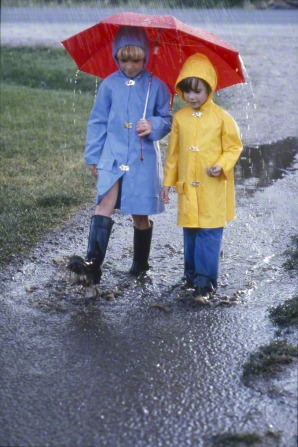The young child splashes in the rain with his sister. “This is fun! I like the rain and the puddles,” she says. The child begins to overcome feelings of fear and starts to splash in the water, which he now knows are called puddles. He changes his feeling about the rain and puddle because of the experience.
The young child watches with wide eyes as he sees his mother cry. The wise mother hugs him and gives him the words to describe what he is seeing. “Mommy is sad because my friend is moving. I know it will be okay, but it makes my heart hurt. I will miss her.” The little boy touches her face and wipes away a tear.
The young child feels the sun on her face as she walks through the forest path with her hand in her teacher’s hand. “I love seeing all the colors, feeling the sunshine and hearing the birds sing,” the teacher states. The young child looks up at her face. “Are you happy?” The teacher smiles down and answers, “I feel joy to be here. I feel safe. I feel grateful. I feel content.” The child nods and continues walking.
In these instances, the adults in the room (or the older sibling) were helping the children put words to what the child was experiencing (a good way to learn a language). In much the same spirit, we can help the children EXPERIENCE a word in the song that they may not understand. Concrete (meaning touchable, seeable, smellable, moveable) Word Stand In is a perfect way to deepen understanding of the lyrics of a song AND to move to the song.
Tell the children we are going to sing the song, but when we sing this word, we will do this action. You might even involve the children in making up the action for the word. (What will our hands do to show the word temple? What action can we do for the word grow?)
Here are some possibilities:
If the word in the song is: Then a possibility for a concrete word stand in might be:
follow: Have your thumb on the right hand follow your left hand thumb as it moves out in front of you. (See also the American Sign Language motion for follow.)
tenderness: Touch your cheek gently.
sacrifice: Pull both hands to your heart in a fist, then in one motion open your fists and open your arms in front of you as if giving someone something.
faithfully: Point to your head then grab onto a pretend walking stick firmly up around your head area. (You might want to use the American Sign Language sign for faith.)
prophet: Hold your hand over your eyes, looking far into the distance. Now hold your hand behind your ear as if listening and turn your ear up to heaven.
Sing the song using the movements for particular words. As an extender activity, ask the children to sing only the words where you are not moving. Instead of singing with those words, move instead. It becomes a challenge to NOT sing and to move instead!
One little extra hint about this activity… the movement instead of a word is a huge help for memory. The brain catalogs words and movements in two different areas. Using them both strengthens the memory and meaning of the song. The body experience of representing the word with movement opens the understanding of the children to new concepts they wouldn’t understand with the word alone. You are actually helping the children’s brains!<grin>
This example uses actions for different words of the song, which is the same concept as Concrete Word Stand In.


Leave a Reply